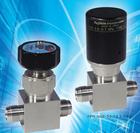WUXI SHINDEN MODERN INTELLIGENT TECHNOLOGY CO.,LTD , https://www.myshinden.com Diaphragm valves use a corrosion-resistant lining body and a corrosion-resistant diaphragm to replace the valve plug assembly and use the movement of the diaphragm to act as a regulator. Diaphragm valve body material is cast iron, cast steel, or cast stainless steel, and lined with a variety of corrosion-resistant or wear-resistant materials, rubber diaphragm material and PTFE. The lining separator has strong corrosion resistance and is suitable for the adjustment of strong corrosive media such as strong acids and alkalis.
Diaphragm valves use a corrosion-resistant lining body and a corrosion-resistant diaphragm to replace the valve plug assembly and use the movement of the diaphragm to act as a regulator. Diaphragm valve body material is cast iron, cast steel, or cast stainless steel, and lined with a variety of corrosion-resistant or wear-resistant materials, rubber diaphragm material and PTFE. The lining separator has strong corrosion resistance and is suitable for the adjustment of strong corrosive media such as strong acids and alkalis.
Diaphragm valve is simple in structure, low in fluid resistance, and has larger flow capacity than other types of valves of the same specification; it can be used for the regulation of high viscosity and suspended particulate media without leakage. The diaphragm isolates the medium from the upper stem cavity, so there is no leakage of filler media. However, due to the limitations of separators and lining materials, pressure resistance and temperature resistance are poor. Generally, they are only applicable to 1.6 MPa nominal pressure and 150°C or lower.
The flow characteristics of the diaphragm valve are close to the quick opening characteristics, approximately linear before the 60% stroke, and the flow rate after 60% is not much changed. Pneumatic diaphragm valves can also be attached with feedback signals, limiters and positioners to meet the needs of automatic control, program control or flow regulation. The feedback signal of pneumatic diaphragm valve adopts non-contact sensing technology. The product adopts a film-type propulsion cylinder instead of a piston cylinder, which eliminates the disadvantages that the piston ring is easily damaged and causes leakage and can not push the valve to open or close. When the air source fails, the handwheel can still be operated to open and close the valve.